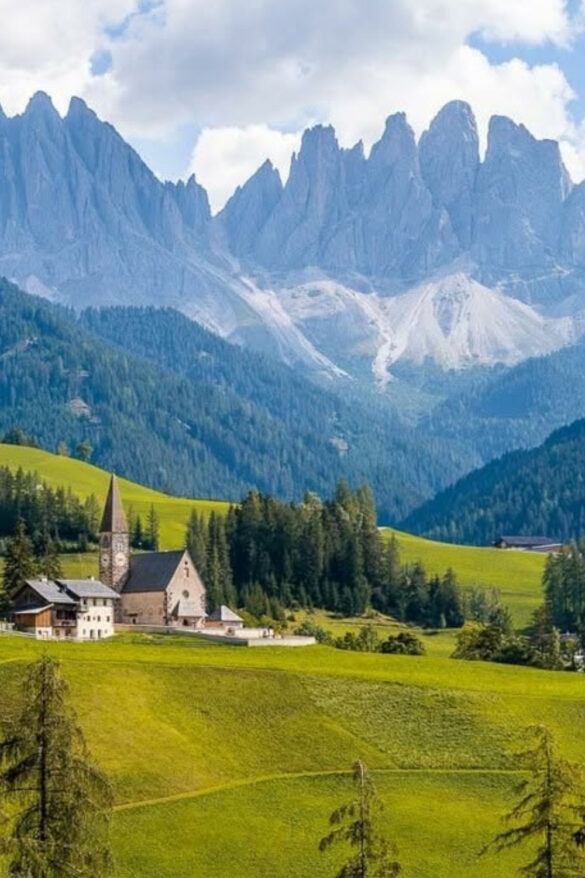Bali, often dubbed the “Island of the Gods,” conjures images of pristine beaches, luxurious resorts, and vibrant nightlife. While these aspects undoubtedly contribute to its allure, a deeper, more profound experience awaits those who venture beyond the beach and delve into the cultural heart of Bali. This mystical island nation, part of Indonesia, is a tapestry woven with ancient traditions, spiritual practices, artistic expressions, and a unique way of life that captivates and enriches every visitor. To truly understand Bali is to embrace its rich heritage, moving beyond the superficial to connect with its soul.
The island’s culture is a living, breathing entity, deeply intertwined with its spiritual beliefs. Hinduism, specifically a Balinese variant known as Agama Hindu Dharma, is not merely a religion but a philosophy that permeates every facet of daily life. From the intricate offerings placed at household shrines to the grand temple ceremonies, every action is imbued with spiritual significance. This pervasive spirituality fosters a sense of harmony, both within the community and with the natural world, a concept known as “Tri Hita Karana” – the three causes of well-being: harmony among people, harmony with nature, and harmony with God. This foundational principle is key to understanding the tranquility and inherent beauty that defines the cultural heart of Bali.
Beyond the well-trodden tourist paths, one discovers a land where ancient customs are meticulously preserved, where art is an act of devotion, and where the rhythm of life is set by the celestial calendar. This blog post aims to guide you through this fascinating journey, revealing the layers of Balinese culture that lie beneath its stunning natural beauty. We will explore the spiritual landscape, the vibrant arts scene, the warmth of its people, and the historical narratives that have shaped this extraordinary island. So, prepare to embark on an exploration that goes beyond the beach and into the very essence of what makes Bali so truly magical.

The Spiritual Core: Unveiling Balinese Hinduism and Its Ceremonies
Bali is deeply spiritual; it is a special brand of Hinduism called Agama Hindu Dharma. This is not merely a religion in a temple, but an active philosophy, which controls the tempo of everyday existence, and colors all that pertains to social manners, as well as to art. In contrast to the more austere types of Hinduism elsewhere, Balinese Hinduism is far more entrenched in the ancestor cult and animism, existing in perfect harmony with the veneration of Hindu deities such as Brahma, Vishnu, and Shiva. The belief system is Tri Hita Karana, a very strong concept that underlines the manifestation of harmony between man, God and nature. This philosophy is clearly manifested in the design of villages, the lines of homes and in the various offerings that are always offered as a reminder to keep balance and to be respectful at all times.
The Calendar of the Balinese is a network of sacred days and rituals due to the lunar Pawukon, along with the solar Saka system. These ceremonies are not just formalities, but living, breathing, community-wide events that are a primary aspect in life. The most pervasive and most visually stimulating is the daily Canang Sari offering. These tiny, highly-woven palm-leaf baskets are used to put out the flowers, rice and incense in front of homes, on sidewalks and at shrines, as an offering to the deities and a means of balancing the cosmos. The Balinese consider the making and setting of these offerings a meditative practice, a silent devotional act that occurs several times per day.
The other underlying pillar of Balinese spirituality is the idea of a multi-layer universe. It is a cosmology that separates the world into three worlds: the upper world (heaven, populated with gods), the human world, and the underworld (populated with demons). Balinese rituals usually have the intention of pacifying the lower world in order to balance the middle world. We can convincingly see this in the Odalan ceremony, a great temple anniversary ceremony, which is performed every 210 days. The events are a festival of color and noise, accompanied by elaborate processions, traditional music (gamelan), dancing performances and a plethora of food preparations. Of course, tourists are usually welcome to observe, but they have to put on a sarong and sash, and need to retain a respectful attitude. They are the sweet rituals, which are not conducted in front of the audience and that is a pure kind of a devotion and it provides a very rare opportunity to enter into the spiritual heart of Bali.
The Ngaben or cremation ceremony is perhaps the most widely known and most heartfelt of all Balinese events. The Ngaben is not a sad affair like a Western funeral, but a happy one where it is celebrated that the deceased has been relieved of the burden of the body. Balinese people believe that the soul is reborn, and the burning of the body is one of the most important steps to release the soul. The corpse is laid in a splendidly adorned sarcophagus, sometimes of the form of a bull or a lion, and a great procession is led to the place of cremation. Gamelan music and chant fill the air when the community gathers to say goodbye. This may appear weird to a foreigner, but it is a strong and group declaration of the cyclical nature of life, a deep and significant statement of Balinese belief. Any person who wants to do more than go to the beach: visit the cultural center of Bali has to watch or read about these rituals.
Ubud: The Epicenter of Balinese Arts and Crafts
The island of Bali has natural beauty that attracts tourists worldwide, but the town of Ubud is the real cultural center of the island. Situated between fertile rice fields and sheer ravines, Ubud is home to artists, spiritual enthusiasts, and anyone willing to be engulfed by the creative essence of the island. Its name, which means in Balinese ubad, meaning medicine, refers to its pre-historic origins as a medical place. Ubud today finds its medicine in its ability to revitalize the soul through art which is firmly embedded in the community.
Ubud is an extremely diverse artistic environment with centuries of impact and creativity. The town is known to be the place where woodcarving, intricate silver work, and detailed paintings are done. Traditionally the art in Bali was commissioned as a form of worship and the painters and sculptors were servants to the royal courts and temples. The practice is still there, albeit in a contemporary manner. An example of such a museum is the Puri Lukisan Museum, which has a wide range of Balinese art, including traditional Kamasan paintings and more modern art. It provides an excellent account of how Balinese art has developed over the centuries, without ever losing its distinctive, spiritual essence.
In addition to the museums, the art scene in Ubud is a living breathing thing. The galleries and workshops where you can find artists at work line the streets. To get a very practical experience, several workshops are providing classes in painting or batik or silver jewelry making. This is one of the strongest methods to get in touch with the local culture and make your own specific souvenir. Another sensual treat is the Ubud Art Market, which is a maze of stalls where hand-carved statues, woven bags, and colored fabrics abound. Although the act of haggling is part of the fun, it is important to remember that you are helping local artisans and their families.
Balinese dance is one of the most fascinating forms of art to observe in Ubud. These are not mere dances, but religious ceremonies narrating ancient tales of deities, heroes and demons. The motions are exceedingly fine, even down to the fluttering of fingers. Night shows are held in many restaurants and performance venues. The best known are the hypnotic Kecak Fire Dance, where men sing to a rhythmic tune in a chorus, and the beautiful Legong Dance, which is performed by young girls. Such dances are a vivid visual expression of the myths and legends that are the very basis of Balinese faith. To get a better insight into this side of the cultural core of Bali, look to the smaller-scale, more intimate performances in town temples.
Ubud is also a literary center, as well as a creative city. Ubud also hosts the Ubud Writers and Readers Festival, one of the most popular events in the world, which attracts literature and thinkers across the globe. The combination of this intellectual energy and the beautiful natural environment of the town provides an aura of deep inspiration. No wonder Ubud has attracted so many artists and creators not only to reside there, but to create and be connected to a culture that makes art a form of prayer. In order to fully appreciate that which lies beyond the beach: it is non-negotiable to make a pilgrimage to Ubud, the cultural heart of Bali.
Fun Fact: Ubud gained a great artistic heritage in the 1920s and 30s when European artists such as Walter Spies and Rudolf Bonnet moved in. They gave the local artists the challenge to embrace new techniques and materials but preserve their traditional subjects and styles, the co-operation resulted in the blossoming of contemporary Balinese art.

Culinary Journey: Savoring the Flavors of the Cultural Heart of Bali
Any trip outside the beach and into the cultural core of Bali cannot be complete without delving into her rich and vibrant culinary scene. The Balinese food is an emblem of its history, religion and fertile land. It is a complex combination of tastes, sweet, sour, salty, and spicy that is often made by using a special mixture of spices and herbs. Balinese cuisine is primarily made of the cornerstone of Balinese cooking, which is the bumbu or the complex spice paste on which many recipes are based. This mixture usually consists of shallots, garlic, ginger, turmeric, chili and a multiplicity of other local goods, forming a fragrance base that is unmistakably Balinese. Food preparation and consumption is a group and religious practice and is commonly integrated with rituals and family times.
Babi Guling, or roasted suckling pig is one of the most famous and popular dishes in Bali. It is an actual masterpiece of cooking, consumed on big occasions and festivals, but nowadays you can find it in any local restaurant. The pig is filled with a hot mixture of spices, herbs, and aromatics and then roasted slowly on an open fire until the pig skin is crispy and the meat of the pig is tender and juicy. Babi Guling is a love story and it takes a whole day and the efforts of the whole community to prepare it. It is a strong image of joy and unity.
The other classic Balinese food is the Lawar, a salad made of mixed vegetables and meat which perfectly sums up the culinary philosophy of the island. Lawar is a ruminant preparation of finely chopped vegetables, grated coconuts and minced meat (pork, chicken, or duck), stirred with a large portion of bumbu. It is of two kinds, lawar merah (red lawar), coloured by fresh pig blood, and lawar putih (white lawar), lighter and more popular. The Lawar preparation is a shared activity and various members of the family have a role to play that binds the community together, as it is one of the reasons why Balinese life will always be close-knit.
Balinese food also has a variety of tasty vegetarian choices, if someone does not want to eat meat. The much-loved gado-gado is a salad of blanched vegetables, tofu and hard-boiled eggs, which are generously dipped in a dense peanut sauce. The rich colours and textures, make it as attractive to the eye as it would be to the palate. The other easy but good food is Nasi Campur, which means mixed rice. This dish is a gorgeous display of tiny plates of different Balinese delicacies, including grilled chicken skewers (satay), boiled eggs with chili and numerous types of vegetable curry all served on top of a now-cooked rice. It is an excellent and delicious introduction to the diversity of Balinese food and a fantastic sample of several flavors at once.
Balinese food is not only about the taste, but about the people being together. Spending time in a local warung (small family-owned restaurant) or a traditional night market is a great place to get a real feel of local life. In this case, you will be able to witness the elaborate preparation procedure and mingle with the genial natives. The experience of trying new dishes and flavors is a major aspect of the adventure to find the soul of the island. The mixture of bold, aromatic and richly fulfilling flavors is a testament to the rich cultural tapestry of Bali and a physical reminiscence of its spiritual origins. You have to eat Bali in order to completely experience the cultural core of this amazing place, a bite of the delicious cuisine at a time.
The most important Spices and Ingredients of the Balinese people:
- Bumbu Genep: The all-purpose spice mixture.
- Turmeric: It is used due to its colorful appearance and the taste of earthiness.
- Chili: One of the basic ingredients to add spiciness and complexity.
- Galangal: This is a ginger-like root that has a peppery, citrus flavour.
- Kaffir Lime Leaves: This has a distinct and fragrant citrus taste.
Conclusion: A Deeper Connection to the Island of the Gods
We have discovered, as we have travelled outside the beach, and into the cultural core of Bali, a world that is far richer and deeper than the vacation experience would suggest. Bali is not just a tourism attraction site; it is an alive breathing monument to a culture that has carefully maintained its traditions, spiritual values and artistic forms amid extreme modernization. The beauty of the island is not only in the beautiful scenery but also in the natural warmness and elegance of the people of this country, a feature that is enshrined in the core philosophy of their Tri Hita Karana.
We have observed the influence of Balinese Hinduism on all spheres of daily life, including such simple, but heartfelt offerings as Canang Sari, and the great and community-wide spectacle of Ngaben cremation ceremony. There were no rituals practiced before, rituals are a breathing dialogue between the divine and human and the ongoing struggle to establish a harmony and balance. We have discussed Ubud not only as a town, but as a place of artistic expression, where art is a form of worship and where tradition is honored through dance, sculpture and painting. This is a creative energy which can be felt and this is what makes visitors not only visit, but also participate and create. And lastly we have sampled the very soul of the island in its fragrant and diverse cuisine, a dining experience that reflects the intricate tapestry of flavors and shared connections that define the island.
In order to really relate to Bali, one has to look past the superficial and get into its soul. This means:
- Observing the Local Customs: Wear a sarong and sash when you pay a visit to a temple. Be quiet at ceremonies. Do not forget you are a visitor in a sacred place.
- Promoting Local Artisans: Buy your souvenirs in local small shops and markets, run by families. Talk to the makers about how they made their crafts.
- Getting to know the Community: Have a cooking lesson, attend a dance lesson, or just sit down and talk to a local. The Balinese are extremely hospitable and their tales are the soul of the island.
- Be a Conscious Traveler: If you want to make a choice, choose tours and hotels that promote sustainable and ethical tourism. Reduce the impact on the environment you are in and invest back to the local economy.
When you choose to explore the cultural hub of Bali, you are not just crossing off a checklist, but you are embarking on a journey of transformation. You are exposing yourself to another form of life, one that is community-oriented, spiritual, and one that greatly respects the natural world. The souvenirs you bring back will not be of beautiful beaches but of a culture that helps us to remember that there is beauty in tradition, the power of belief, and the universal language of art. Live what you love, as the Balinese say, “Hidupkanlah apa yang kamu sukai” And in Bali, what they embrace is a life of harmony, and a love that they so freely give to the world.

References:- Exploring the Cultural Heart of Bali
- Puri Lukisan Museum: A historical and artistic resource for Balinese painting.
- “Bali: Sekala and Niskala” by Fred B. Eiseman Jr.: A comprehensive two-volume book that provides an in-depth look at Balinese culture, history, and daily life.
- “A Little Bit of Bali” by Liz Price: A more accessible guide to understanding Balinese customs and traditions.
- Various academic papers on Tri Hita Karana: The philosophical concept is widely researched and is a cornerstone of Balinese studies.





